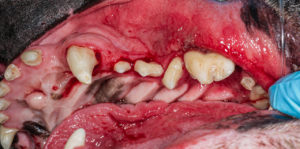Zoey was a typical goofy shepherd mix. When her owner noticed excessive drooling and a reluctance to eat in the normally happy dog, she sought veterinary help. Zoey’s condition was diagnosed as canine chronic ulcerative stomatitis (CCUS).
Signs of Stomatitis
Dogs suffering from this disease develop severe inflammation and oral ulcers on the tongue, the mucosa (the lining of the cheeks), and the inner  surfaces of the lips. Because it’s so painful, a dog may have difficulty eating and be reluctant to open the mouth. This can result in weight loss. Other typical signs include fetid breath, thick, ropey saliva, irritability, depression and lethargy, and pawing at the mouth.
surfaces of the lips. Because it’s so painful, a dog may have difficulty eating and be reluctant to open the mouth. This can result in weight loss. Other typical signs include fetid breath, thick, ropey saliva, irritability, depression and lethargy, and pawing at the mouth.
While bad breath, constant drooling, and difficulty eating are key indicators, veterinary dentist Jamie Anderson, DVM, MS, DAVDC, DACVIM, adjunct professor at the Department of Oral Medicine, School of Dental Medicine, University of Pennsylvania, says a veterinary consultation is essential for proper diagnosis because some other diseases, including cancer, lupus erythematosus, and other autoimmune diseases may present similar signs.
“There is no known cause for the disease,” Dr. Anderson says. “But as a result of extensive research we do know that CCUS is not directly related to periodontal disease, as was previously thought. Nevertheless, heavy plaque on the teeth can make this condition more difficult to manage and there’s no doubt that a patient can feel better if the mouth is clean.”
It is common for veterinary dentists to extract healthy teeth to remove the plaque that they believe to be causing the disease, but Anderson says that instead the focus should be on extracting only what are known as “hopeless” teeth — those that are no longer functional and that cause inflammation due to periodontal disease or endodontic disease.
Susceptible Breeds
Breeds most commonly affected include Maltese, Norwich Terriers, Labrador Retrievers, Greyhounds, Miniature Schnauzers, Chihuahuas, and Cavalier King Charles Spaniels. The condition is generally seen in dogs six years and older.
When various courses of antibiotics administered to Zoey had no effect and the dog continued to struggle to eat, her owner consulted Anderson for a teeth cleaning and an evaluation.
Anderson, who has been researching this disease since 2013 and has overseen numerous successful studies involving the use of a trio of medications, prescribed a combo of Pentoxifylline, Doxycycline, and Niacinamide which brought Zoey relief and kept her ulcer-free and comfortable for years.
“However, between professional cleanings, the issue reappeared,” her owner recalls. “Consequently, her prescription was changed to a regimen of Niacinamide, Pentoxifylline, and Metronidazole and we have never looked back! The lesions and inflammation in her mouth have cleared up completely and, Zoey, who is now 12 years old, is totally pain-free and back to eating with gusto. I continue to be very meticulous about her dental hygiene and we take her for annual teeth-cleaning to ensure a healthy mouth.”
Anderson reiterates the importance of good dental hygiene and suggests the following tips for care.
Checklist for a Healthy Mouth
- Dogs should allow you to lift the jowls and inspect their teeth. Treat any reluctance seriously and seek veterinary help.
- Pay attention to bad breath. It’s a key indicator that there could be issues that need addressing.
- Dogs who paw at the mouth may be trying to tell you they’re in pain.
- Dogs who are normally good eaters but are suddenly walking away from the bowl may have a painful mouth.
- There are numerous products approved by the Veterinary Oral Health Council such as canine toothbrushes, toothpastes, dental wipes, and water additives that allow you to create a simple dental hygiene routine.
- February is National Pet Dental Health Month. Your veterinarian may offer discounts and dental product specials during that time, but if you suspect an issue, don’t wait for February to come up on the calendar again before seeking help.
This article was reviewed/edited by board-certified veterinary behaviorist Dr. Kenneth Martin and/or veterinary technician specialist in behavior Debbie Martin, LVT.








